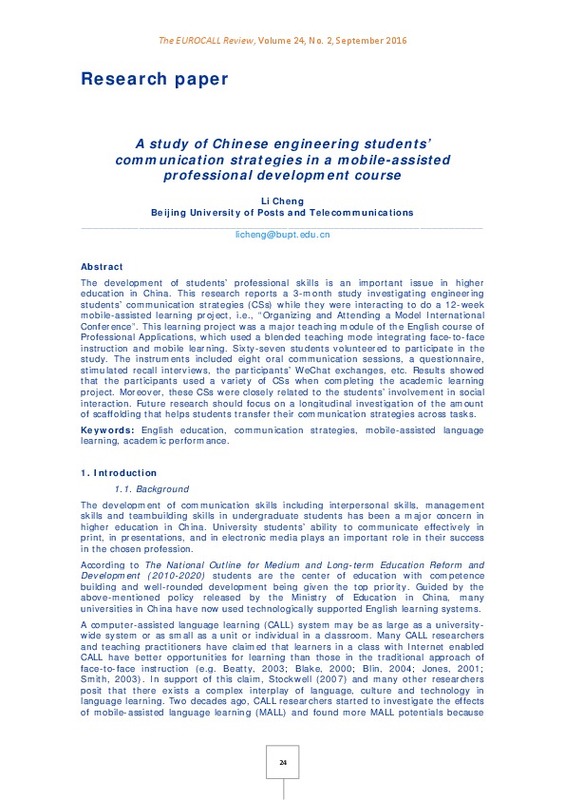Beatty, K., & Nunan, D. (2004). Computer-mediated collaborative learning. System, 32(2), 165-183. doi:10.1016/j.system.2003.11.006
Bialystok, E. (1990). Communication strategies. Oxford: Blackwell.
Blake, R., (2000). Computer mediated communication: a window on L2 Spanish interlanguage. Language Learning and Technology 4(1), 120-136.
[+]
Beatty, K., & Nunan, D. (2004). Computer-mediated collaborative learning. System, 32(2), 165-183. doi:10.1016/j.system.2003.11.006
Bialystok, E. (1990). Communication strategies. Oxford: Blackwell.
Blake, R., (2000). Computer mediated communication: a window on L2 Spanish interlanguage. Language Learning and Technology 4(1), 120-136.
BLIN, F. (2004). CALL and the development of learner autonomy: Towards an activity-theoretical perspective. ReCALL, 16(2), 377-395. doi:10.1017/s0958344004000928
Cummins, J. (1979). Linguistic Interdependence and the Educational Development of Bilingual Children. Review of Educational Research, 49(2), 222-251. doi:10.3102/00346543049002222
Cummins, J. (s. f.). Interdependence of first- and second-language proficiency in bilingual children. Language processing in bilingual children, 70-89. doi:10.1017/cbo9780511620652.006
Cummins, J., & Swain, M. (1986). Linguistic interdependence: A central principle of bilingual education. In J. Cummins and M. Swain (Eds.), Bilingualism in education: Aspects of theory, research, and practice (pp. 80-95). New York: Longman.
Dörnyei, Z., & Scott, M. L. (1997). Communication Strategies in a Second Language: Definitions and Taxonomies. Language Learning, 47(1), 173-210. doi:10.1111/0023-8333.51997005
Duff, P. A. (2000). Repetition in foreign language classroom interaction. In J. K. Hall & L. Verplaetse (Eds.), Second and foreign language learning through classroom interaction (pp. 109-138). Mahwah, NJ: Lawrence Erlbaum.
Faerch, C., & Kasper, G. (1983). Plans and strategies in foreign language communication. In C. Faerch & G. Kasper (Eds.), Strategies in interlanguage communication (pp. 20-60). Harlow: Longman.
Gass, S., & Mackey, A. (2000). Stimulated recall methodology in second language research, Mahwah, NJ: Lawrence Erlbaum Associates.
Godwin-Jones, R. (2008). Emerging technologies mobile-computing trends: Lighter, Faster, Smarter. Language Learning & Technology, 12(2), 7-13.
Godwin-Jones, R. (2011). Mobile apps for language learning. Language Learning & Technology, 15(2), 2-11.
Jones, J. (2001). CALL and the responsibilities of teachers and administrators. ELT Journal, 55(4), 360-367. doi:10.1093/elt/55.4.360
Kasper, G., & Kellerman, E. (Eds.) (1997). Communication strategies: Psycholinguistic and sociolinguistic perspectives. London: Longman.
Lafford, B. A. (2004). THE EFFECT OF THE CONTEXT OF LEARNING ON THE USE OF COMMUNICATION STRATEGIES BY LEARNERS OF SPANISH AS A SECOND LANGUAGE. Studies in Second Language Acquisition, 26(02). doi:10.1017/s0272263104262039
Lam, W. Y. K. (2006). Gauging the effects of ESL oral communication strategy teaching: a multi-method approach. Electronic Journal of Foreign Language Teaching 3 (2), 142–157.
Nunan, D. (2004). Task-Based Language Teaching. doi:10.1017/cbo9780511667336
Omar, H., Embi, M. A., & Yunus, M. M. (2012). Learners’ use of Communication Strategies in an Online Discussion via Facebook. Procedia - Social and Behavioral Sciences, 64, 535-544. doi:10.1016/j.sbspro.2012.11.063
Selinker, L. (1972). INTERLANGUAGE. IRAL - International Review of Applied Linguistics in Language Teaching, 10(1-4). doi:10.1515/iral.1972.10.1-4.209
Smith, B. (2003). The use of communication strategies in computer-mediated communication. System, 31(1), 29-53. doi:10.1016/s0346-251x(02)00072-6
STOCKWELL, G. (2007). A review of technology choice for teaching language skills and areas in the CALL literature. ReCALL, 19(2), 105-120. doi:10.1017/s0958344007000225
Tarone, E. (1980). COMMUNICATION STRATEGIES, FOREIGNER TALK, AND REPAIR IN INTERLANGUAGE1. Language Learning, 30(2), 417-428. doi:10.1111/j.1467-1770.1980.tb00326.x
Varadi, T. (1980). Strategies of target language learner communication: Message adjustment. International Review of Applied Linguistics, 18, 59-71.
[-]








